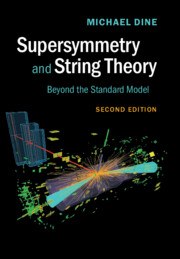Book contents
- Frontmatter
- Dedication
- Contents
- Preface to the First Edition
- Preface to the Second Edition
- A note on the choice of metric
- Text website
- Part 1 Effective field theory: the StandardModel, supersymmetry, unification
- Part 2 Supersymmetry
- Part 3 String theory
- 20 Introduction
- 21 The bosonic string
- 22 The superstring
- 23 The heterotic string
- 24 Effective actions in ten dimensions
- 25 Compactification of string theory I. Tori and orbifolds
- 26 Compactification of string theory II. Calabi–Yau compactifications
- 27 Dynamics of string theory at weak coupling
- 28 Beyond weak coupling: non-perturbative string theory
- 29 Large and warped extra dimensions
- 30 The landscape: a challenge to the naturalness principle
- 31 Coda: Where are we heading?
- Part 4 Appendices
- References
- Index
27 - Dynamics of string theory at weak coupling
from Part 3 - String theory
- Frontmatter
- Dedication
- Contents
- Preface to the First Edition
- Preface to the Second Edition
- A note on the choice of metric
- Text website
- Part 1 Effective field theory: the StandardModel, supersymmetry, unification
- Part 2 Supersymmetry
- Part 3 String theory
- 20 Introduction
- 21 The bosonic string
- 22 The superstring
- 23 The heterotic string
- 24 Effective actions in ten dimensions
- 25 Compactification of string theory I. Tori and orbifolds
- 26 Compactification of string theory II. Calabi–Yau compactifications
- 27 Dynamics of string theory at weak coupling
- 28 Beyond weak coupling: non-perturbative string theory
- 29 Large and warped extra dimensions
- 30 The landscape: a challenge to the naturalness principle
- 31 Coda: Where are we heading?
- Part 4 Appendices
- References
- Index
Summary
In previous chapters we have seen that string theory at the classical level shows promise of describing the Standard Model and can realize at least one scenario for the physics beyond: low-energy supersymmetry. But there are many puzzles, most importantly the existence of moduli and the related question of the cosmological constant. At tree level, in the Calabi– Yau solutions the cosmological constant vanishes. But whether this holds in perturbation theory and beyond requires an understanding of the quantum theory.
In studying string theory, we have certain tools:
weak coupling expansions;
long-wavelength (low-momentum, α′) expansions.
We have exploited both these techniques already. In analyzing string spectra we worked in a weak coupling limit. There are corrections to the masses and couplings, for example; in string perturbation theory all but a few states that we have studied have finite lifetimes. At weak coupling these effects are small, but at strong coupling the theories will presumably look dramatically different.
In asserting that Calabi–Yau vacua are solutions of the string equations, we used both the above types of expansion. We wrote down the string equations both in lowest order in the string coupling and also with the fewest number of derivatives (two). Even at weak coupling and in the derivative expansion, we can ask whether Calabi–Yau spaces are actually solutions of the string equations, both classically and quantum mechanically. For example, we have seen that, at lowest order in both expansions, there are typically many massless particles. We might expect tadpoles to appear for these fields, both in the α′ expansion and in loops. There is in general no guarantee that we can find a sensible solution by simply perturbing the original one.
Yet there are many cases where we can make exact statements. In both Type II and heterotic string theories, we can often show that Calabi–Yau vacua correspond to exact solutions of the classical string equations. We can also show that they are good vacua – there are no tadpoles for massless fields – to all orders of the string perturbation expansion. More dramatically, we can sometimes show that these vacua are good, nonperturbative, states of the theory. This is perhaps surprising since we lack a suitable nonperturbative formulation in which to address this question directly. The key to this magic is supersymmetry.
- Type
- Chapter
- Information
- Supersymmetry and String TheoryBeyond the Standard Model, pp. 397 - 407Publisher: Cambridge University PressPrint publication year: 2016



